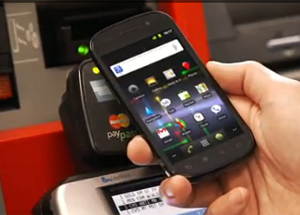Getting a feature to take off in today’s smartphone market is tricky. It requires a combination of hardware support, OS support, app integration, and maybe most importantly carrier adoption. Ideas that seem ready technologically, like NFC, get stopped in their tracks by silly things like the William J. LePetomaine Thruway toll booth.
Google and NFC are stuck right now. Today’s Bloomberg article is good reading:
http://www.bloomberg.com/news/2012-03-21/google-said-to-rethink-wallet-strategy-amid-slow-adoption.html
Google aims to spur demand for its Wallet app, which is designed to boost its share of the multibillion-dollar market for mobile advertising by letting it target shoppers with coupons and promotions. The challenge: Few phones have the right technology installed, and rivals are readying their own systems, including one called ISIS that’s backed by carriers.
I’ve been following this one for a while, and it’s particularly disappointing because the press seems to be tossing the NFC baby out with the Google bathwater. Let’s break this down together and see where things might be going wrong.
 Adding NFC hardware to a phone is probably the trivial part of this discussion, on about the same degree of difficulty as Bluetooth. NFC has been used in transportation ticketing applications in Europe and Asia for some time.
Adding NFC hardware to a phone is probably the trivial part of this discussion, on about the same degree of difficulty as Bluetooth. NFC has been used in transportation ticketing applications in Europe and Asia for some time.
Google brought it to the Android party last year, and quickly announced this teaming relationship with MasterCard and First Data on Google Wallet. Of course, there are rampant privacy/security concerns there.
But VISA was missing. And almost everyone – HTC, Motorola, Samsung included – have lined up supporting the Isis Mobile Wallet, backed by Verizon, AT&T, and T-Mobile who want a slice of this payment action. (So far, Google Wallet is only on 2 phones sold by Sprint.)
Then there’s Apple, and their non-approach on NFC so far. They are moving very carefully in payments space, with a stronger partnership with Square which requires no change in consumer behavior since it uses existing mag stripe credit cards. Doing homework finds that behind the scenes, Apple has filed 20+ NFC patents – they understand the potential.
NFC has been locked up tightly with payments, and that’s missing the boat. I was talking with John Ferrell, patent attorney with Carr Ferrell, last fall at CTIA Enterprise & Apps. He said stop limiting NFC to payments, and think about the bigger picture. Walk into a store, and tap a coupon or more info on an item into your phone instead of dealing with the relative complexity of QR codes and scanner apps. Go into a bookstore and get more info on an author, again with nothing but a tap. Tap two phones together – like Bump, except without the cloud – and exchange info between people. The possibilities are huge.
I already mentioned the ticketing potential. In another example, RIM has set up a partnership with Assa Abloy to enable NFC as a key in the BlackBerry Tag system, replacing physical keys or RFID badges for enterprise access control.
But then I grabbed another individual at the CTIA event who works in the payment terminal space, and he said if you’re asking merchants to swap out their proven mag stripe tech and pay for new-fangled NFC tech, without stronger benefits, that’s a problem. It’s akin to the use case of swapping out barcodes for RFID but not really changing the process at the checkout scanner – hard for a small retailer to justify.
You can get away with a lot of things in life, but you’re asking for trouble when you start taking people’s money. Introducing the payment factor in any tech brings in all the concerns about security and who gets paid what to move the estimated $11B we’ll see in mobile payments come 2016. It’s a big deal, and we’ve only mentioned a few of the players – add banks, Verifone, PayPal, ViVOtech, and others.
IMHO, somebody will eventually get a whole mess of dimes, and NFC will break through.
What are your thoughts? Is NFC an important technology, beyond just mobile payments? How about the carriers backing their own wallet tech? Will it take an NFC splash from Apple to get the average person’s attention, or is it simply having phone choices at carriers and then the apps will come? Is this just a case of push, where people don’t really want this (yet), especially if it’s a plot to deliver more ads? Other ideas here? Comments welcome.
(Standard disclaimer: not invested in anyone I’ve mentioned here, unless you count the money I send to Verizon on an unlimited minute/data plan. I have a knack for finding and evangelizing really cool things, some a bit before their time. If you’d like me to help your firm with that, I’m available for hire for projects as a social computing futurist, embedded and mobile marketing strategist, speaker, and storyteller.)
Don Dingee, @L2myowndevices
Share this post via:






Quantum Computing Technologies and Challenges